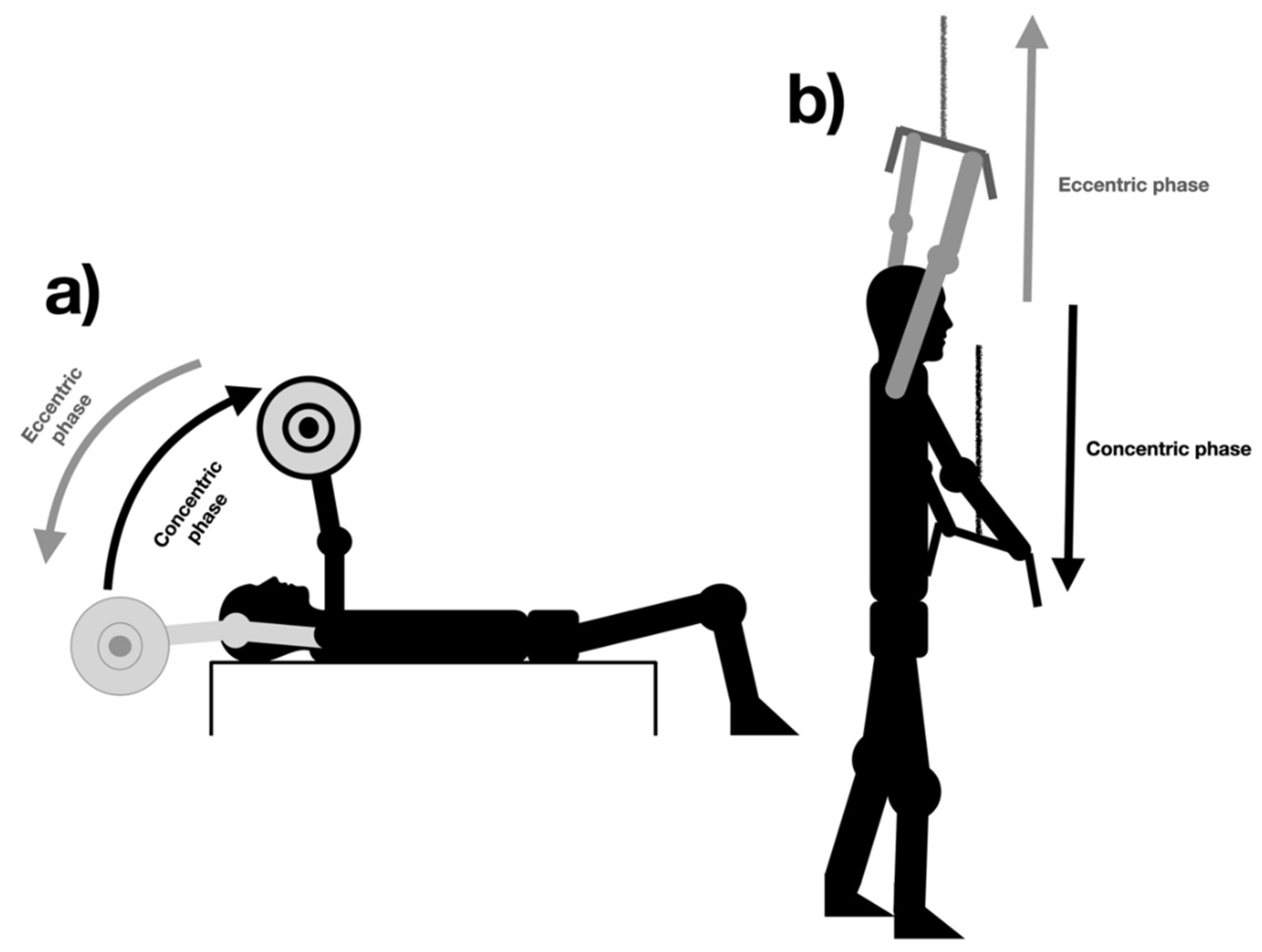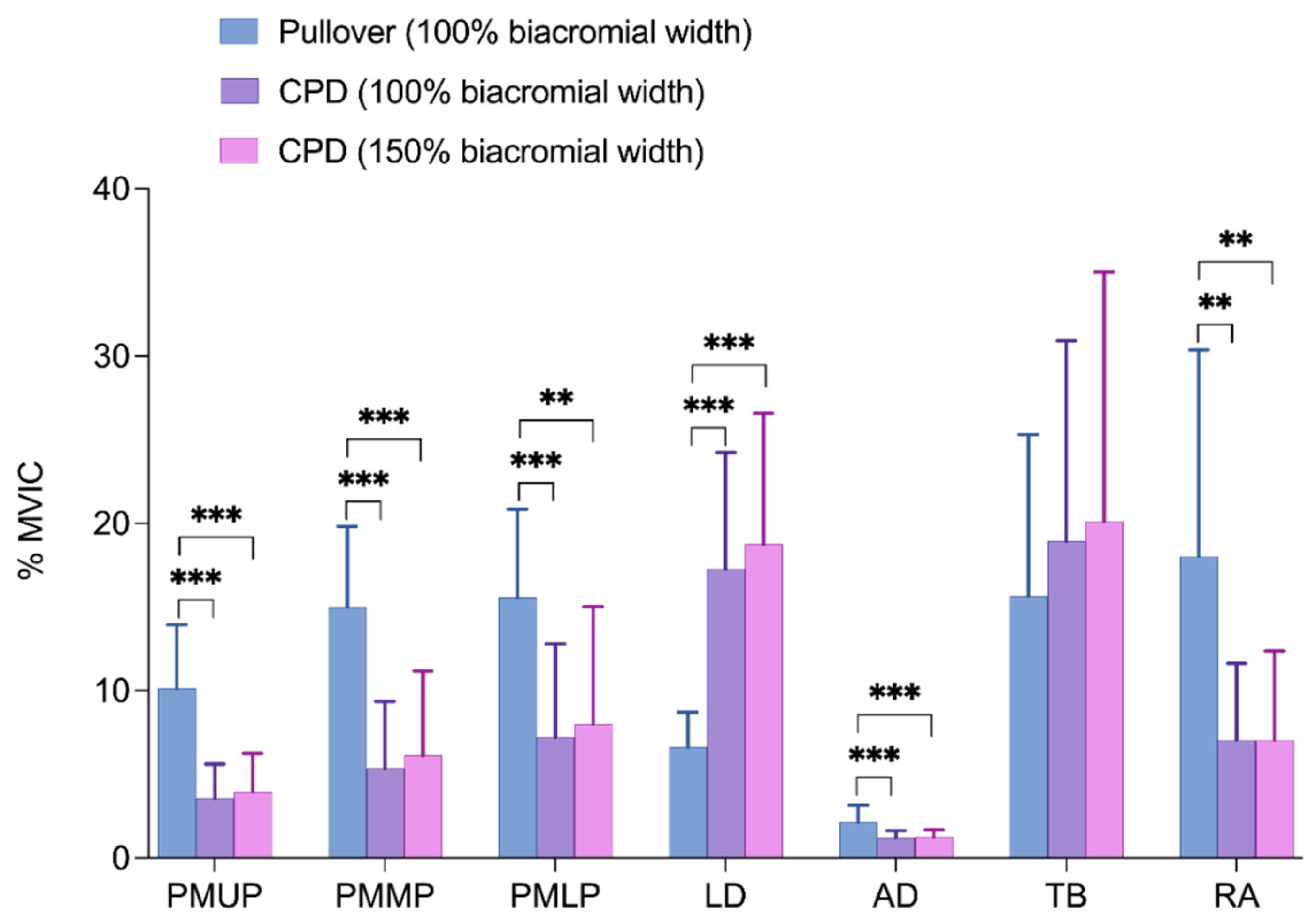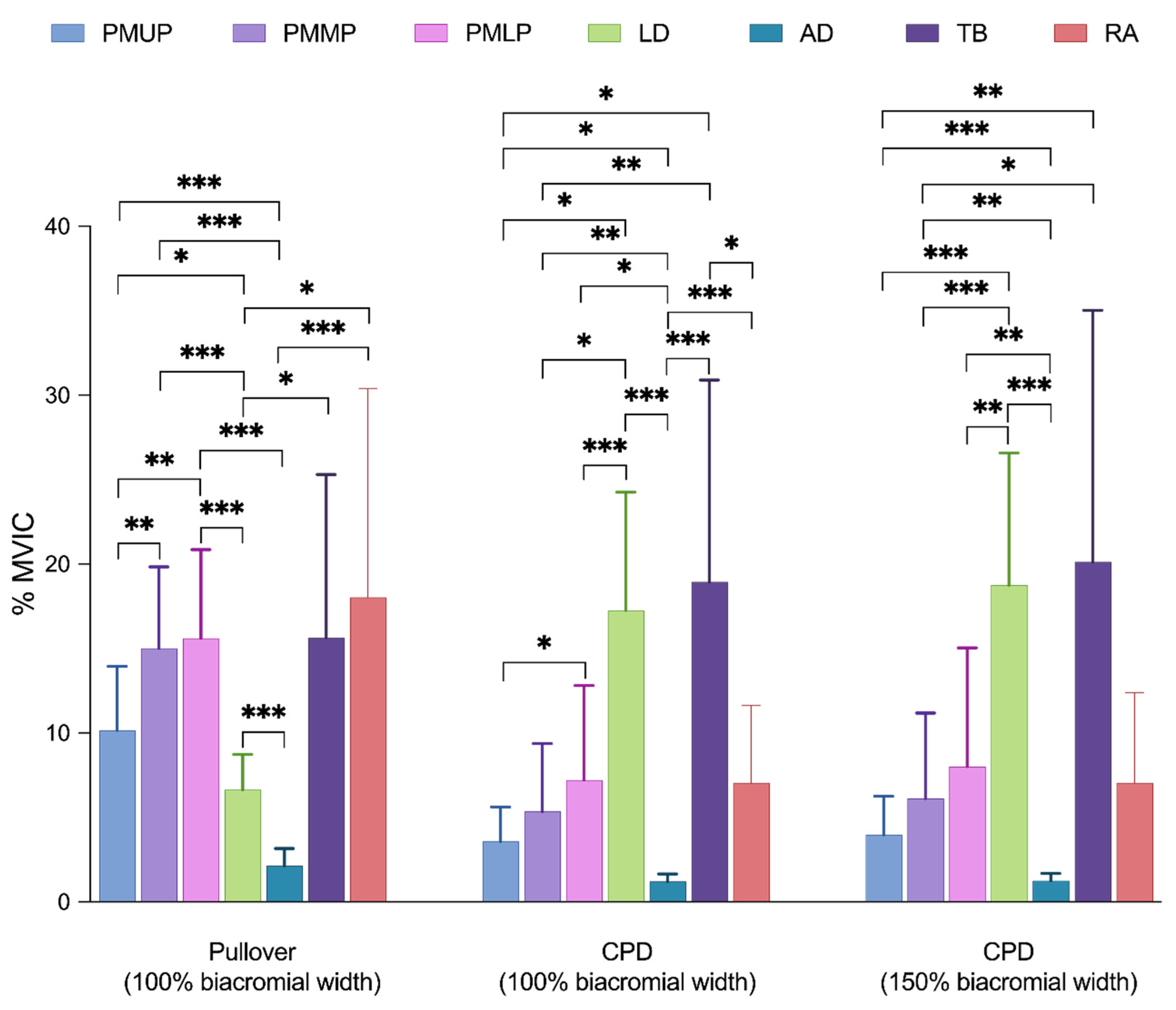Comparison of Electromyographic Activity during Barbell Pullover and Straight Arm Pulldown Exercises
Featured Application
Abstract
1. Introduction
2. Materials and Methods
2.1. Participants
2.2. Procedures
2.3. Electromyography
2.4. Statistical Analysis
3. Results
Subsection
4. Discussion
5. Conclusions
Author Contributions
Funding
Institutional Review Board Statement
Informed Consent Statement
Data Availability Statement
Conflicts of Interest
References
- Langer, K.; Simon, C.; Wiemeyer, J. Strength Training in Climbing: A Systematic Review. J. Strength Cond. Res. 2022. [Google Scholar] [CrossRef]
- Zhang, J. Influence of Progressive Upper Limb Strength Training on Table Tennis Athletes. Rev. Bras. Med. Do Esporte 2022, 28, 734–737. [Google Scholar] [CrossRef]
- Kim, M.; Kuruma, H.; Thawisuk, C. Effectiveness of Elongation Band Exercise on the Upper Limb Strength and Range of Motion among Older Adults. J. Exerc. Rehabil. 2022, 18, 110–116. [Google Scholar] [CrossRef] [PubMed]
- da Silva, P.B.; Antunes, F.N.; Graef, P.; Cechetti, F.; de Souza Pagnussat, A. Strength Training Associated with Task-Oriented Training to Enhance Upper-Limb Motor Function in Elderly Patients with Mild Impairment after Stroke. Am. J. Phys. Med. Rehabil. 2015, 94, 11–19. [Google Scholar] [CrossRef]
- Belfry, G.R.; Noble, E.G.; Taylor, A.W. Effects of Two Different Weight Training Programs on Swimming Performance and Muscle Enzyme Activities and Fiber Type. J. Strength Cond. Res. 2016, 30, 305–310. [Google Scholar] [CrossRef] [PubMed]
- Rud, B.; Øygard, E.; Dahl, E.B.; Paulsen, G.; Losnegard, T. The Effect of Resistance Exercise Priming in the Morning on Afternoon Sprint Cross-Country Skiing Performance. Int. J. Sports Physiol. Perform. 2021, 16, 1786–1793. [Google Scholar] [CrossRef]
- Hermassi, S.; Laudner, K.; Schwesig, R. The Effects of Circuit Strength Training on the Development of Physical Fitness and Performance-Related Variables in Handball Players. J. Hum. Kinet. 2020, 71, 191–203. [Google Scholar] [CrossRef]
- Hermassi, S.; Wollny, R.; Schwesig, R.; Shephard, R.J.; Chelly, M.S. Effects of In-Season Circuit Training on Physical Abilities in Male Handball Players. J. Strength Cond. Res. 2019, 33, 944–957. [Google Scholar] [CrossRef]
- Valadés Cerrato, D.; Palao, J.M.; Femia, P.; Ureña, A. Effect of Eight Weeks of Upper-Body Plyometric Training during the Competitive Season on Professional Female Volleyball Players. J. Sport. Med. Phys. Fit. 2018, 58, 1423–1431. [Google Scholar] [CrossRef]
- Sandbakk, Ø.; Hansen, M.; Ettema, G.; Rønnestad, B. The Effects of Heavy Upper-Body Strength Training on Ice Sledge Hockey Sprint Abilities in World Class Players. Hum. Mov. Sci. 2014, 38, 251–261. [Google Scholar] [CrossRef]
- Janyacharoen, T.; Thayon, M.; Bushong, W.; Jaikla, N.; Sawanyawisuth, K. Effects of Resistance Exercise on Cardiopulmonary Factors in Sedentary Individuals. J. Phys. Ther. Sci. 2016, 28, 213–217. [Google Scholar] [CrossRef] [PubMed]
- Liao, C.-N.; Fan, C.-H.; Hsu, W.-H.; Chang, C.-F.; Yu, P.-A.; Kuo, L.-T.; Lu, B.-L.; Hsu, R.W.-W. Twelve-Week Lower Trapezius-Centred Muscular Training Regimen in University Archers. Healthcare 2022, 10, 171. [Google Scholar] [CrossRef] [PubMed]
- Brigatto, F.A.; Bueno de Camargo, J.B.; Benhur Machado, Y.; Germano, M.D.; Saldanha Aoki, M.; Volpi Braz, T.; Lopes, T.R. Does Split-Body Resistance Training Routine Performed Two versus Three Days per Week Induce Distinct Strength and Morphological Adaptations in Resistance-Trained Men? A Randomized Longitudinal Study. Int. J. Strength Cond. 2022, 2, Page. [Google Scholar] [CrossRef]
- Stastny, P.; Gołaś, A.; Blazek, D.; Maszczyk, A.; Wilk, M.; Pietraszewski, P.; Petr, M.; Uhlir, P.; Zajac, A. A Systematic Review of Surface Electromyography Analyses of the Bench Press Movement Task. PLoS ONE 2017, 12, e0171632. [Google Scholar] [CrossRef]
- Oliva-Lozano, J.M.; Muyor, J.M. Core Muscle Activity during Physical Fitness Exercises: A Systematic Review. Int. J. Environ. Res. Public Health 2020, 17, 4306. [Google Scholar] [CrossRef]
- Martín-Fuentes, I.; Oliva-Lozano, J.M.; Muyor, J.M. Electromyographic Activity in Deadlift Exercise and Its Variants. A Systematic Review. PLoS ONE 2020, 15, e0229507. [Google Scholar] [CrossRef]
- Rabelo Mota, M.; Vieira Bogéa, R.; Pardono, E.; Brito, C.J.; Magalhaes Sales, M.; Guimaraes Boia Do Nascimento, M.; Oliveira Silva, I. Activation of Pectoralis Major and Deltoid during Bench Press and Pullover Exercises until the Concentric Failure. J. Phys. Educ. Sport 2017, 17, 2588–2592. [Google Scholar]
- Teixeira, L.F.M.; Gomes, W.A.; da Silva, J.J.; Magalhaes, R.A.; Marchetti, P.H. Differences between Pullover and Pulldown Exercises on Maximal Isometric Force and Myoelectric Activity in Recreationally-Trained Me. Int. J. Exerc. Sci. 2022, 15, 797–807. [Google Scholar]
- Campos, Y.D.A.C.; da Silva, S.F. Comparison of Electromyographic Activity during the Bench Press and Barbell Pullover Exercises. Mot. Rev. Educ. Fis. 2014, 20, 200–205. [Google Scholar] [CrossRef]
- Marchetti, P.H.; Uchida, M.C. Effects of the Pullover Exercise on the Pectoralis Major and Latissimus Dorsi Muscles as Evaluated by Emg. J. Appl. Biomech. 2011, 27, 380–384. [Google Scholar] [CrossRef]
- Gentil, P.; Fisher, J.; Steele, J. A Review of the Acute Effects and Long-Term Adaptations of Single- and Multi-Joint Exercises during Resistance Training. Sport. Med. 2017, 47, 843–855. [Google Scholar] [CrossRef] [PubMed]
- Ratamess, N. ACSM’s Foundations of Strength Training and Conditioning; Lippincott Williams & Wilkins, Wolters Kluswer: Indianápolis, Indiana, 2012. [Google Scholar]
- Rutkowska-Kucharska, A.; Szpala, A. Electromyographic Muscle Activity in Curl-up Exercises with Different Positions of Upper and Lower Extremities. J. Strength Cond. Res. 2010, 24, 3133–3139. [Google Scholar] [CrossRef] [PubMed]
- Rodríguez-Ridao, D.; Antequera-Vique, J.A.; Martín-Fuentes, I.; Muyor, J.M. Effect of Five Bench Inclinations on the Electromyographic Activity of the Pectoralis Major, Anterior Deltoid, and Triceps Brachii during the Bench Press Exercise. Int. J. Environ. Res. Public Health 2020, 17, 7339. [Google Scholar] [CrossRef] [PubMed]
- Muyor, J.M.; Rodríguez-Ridao, D.; Martín-Fuentes, I.; Antequera-Vique, J.A. Evaluation and Comparison of Electromyographic Activity in Bench Press with Feet on the Ground and Active Hip Flexion. PLoS ONE 2019, 14, e0218209. [Google Scholar] [CrossRef]
- Stegeman, D.; Hermens, H.J. Standards for Surface Electromyography: The European Project Surface EMG for Non-Invasive Assessment of Muscles (SENIAM). Enschede Roessingh Res. Dev. 2007, 1, 108–112. [Google Scholar]
- Glass, S.C.; Armstrong, T. Electromyographical Activity of the Pectoralis Muscle during Incline and Decline Bench Presses. J. Strength Cond. Res. 1997, 11, 163–167. [Google Scholar] [CrossRef]
- Park, K.-M.; Cynn, H.-S.; Yi, C.-H.; Kwon, O.-Y. Effect of Isometric Horizontal Abduction on Pectoralis Major and Serratus Anterior EMG Activity during Three Exercises in Subjects with Scapular Winging. J. Electromyogr. Kinesiol. 2013, 23, 462–468. [Google Scholar] [CrossRef]
- Park, S.; Yoo, W. Selective Activation of the Latissimus Dorsi and the Inferior Fibers of Trapezius at Various Shoulder Angles during Isometric Pull-down Exertion. J. Electromyogr. Kinesiol. 2013, 23, 1350–1355. [Google Scholar] [CrossRef]
- Saeterbakken, A.H.; Fimland, M.S. Electromyographic Activity and 6rm Strength in Bench Press on Stable and Unstable Surfaces. J. Strength Cond. Res. 2013, 27, 1101–1107. [Google Scholar] [CrossRef]
- Cogley, R.M.; Archambault, T.A.; Fibeger, J.F.; Koverman, M.M.; Youdas, J.W.; Hollman, J.H. Comparison of Muscle Activation Using Various Hand Positions during the Push-up Exercise. J. Strength Cond. Res. 2005, 19, 628–633. [Google Scholar]
- Workman, J.C.; Docherty, D.; Parfrey, K.C.; Behm, D.G. Influence of Pelvis Position on the Activation of Abdominal and Hip Flexor Muscles. J. Strength Cond. Res. 2008, 22, 1563–1569. [Google Scholar] [CrossRef] [PubMed]
- Cohen, J. Statistical Power Analysis for the Behavioral Sciences, 2nd ed.; Routledge: Hillsdale, NJ, USA, 2013; ISBN 9780203771587. [Google Scholar]
- Muyor, J.M.; Martín-Fuentes, I.; Rodríguez-Ridao, D.; Antequera-Vique, J.A. Electromyographic Activity in the Gluteus Medius, Gluteus Maximus, Biceps Femoris, Vastus Lateralis, Vastus Medialis and Rectus Femoris during the Monopodal Squat, Forward Lunge and Lateral Step-Up Exercises. PLoS ONE 2020, 15, e0230841. [Google Scholar] [CrossRef] [PubMed]
- Hamill, J.; Knutzen, K.M.; Derrick, T.R. Biomechanical Basis of Human Movement; Lippincott Williams & Wilkins: Philadelphia, PA, USA, 2015. [Google Scholar]
- White, A.A.; Panjabi, M.M. Clinical Biomechanics of the Spine, 2nd ed.; J. B. Lippincott Company: Philadelphia, PA, USA, 1990. [Google Scholar]
- David, P.; Mora, I.; Pérot, C. Neuromuscular Efficiency of the Rectus Abdominis Differs with Gender and Sport Practice. J. Strength Cond. Res. 2008, 22, 1855–1861. [Google Scholar] [CrossRef]
- Snyder, B.J.; Leech, J.R. Voluntary Increase in Latissimus Dorsi Muscle Activity during the Lat Pull-down Following Expert Instruction. J. Strength Cond. Res. 2009, 23, 2204–2209. [Google Scholar] [CrossRef] [PubMed]
- Maffulli, N.; Mikhail, H.M.T. Bilateral Anterior Glenohumeral Dislocation in a Weightlifter. Injury 1990, 21, 254–256. [Google Scholar] [CrossRef]
- Gołaś, A.; Maszczyk, A.; Petr, M.; Statsny, P.; Wilk, M.; Wróbel, G. Changes in Bar Velocity and Muscular Activity during the Bench Press in Relation to the Load Lifted. Cent. Eur. J. Sport Sci. Med. 2015, 11, 95–101. [Google Scholar] [CrossRef][Green Version]



| Variables | Values |
|---|---|
| Age (years) | 26.33 ± 1.95 |
| Body mass (kg) | 74.84 ± 6.14 |
| Height (m) | 1.77 ± 0.07 |
| Body mass index (kg·m−2) | 23.86 ± 1.69 |
| 100% biacromial width (cm) | 44.05 ± 2.18 |
| 150% biacromial width (cm) | 66.07 ± 3.28 |
| Load at 30% of body mass (kg) | 22.45 ± 1.84 |
| Muscle | Concentric | Eccentric | Mean Difference (95% CI) | p-Value | d-Cohen |
|---|---|---|---|---|---|
| PMUP | 165.23 ± 59.20 | 118.93 ± 51.77 | 46.30 ± 32.51 | <0.001 | 1.42 |
| PMMP | 159.86 ± 57.10 | 125.38 ± 52.49 | 34.47 ± 31.57 | <0.001 | 1.09 |
| PMLP | 191.97 ± 61.74 | 143.11 ± 44.49 | 48.86 ± 41.08 | <0.001 | 1.18 |
| LD | 54.12 ± 14.04 | 39.33 ± 13.48 | 14.78 ± 11.60 | <0.001 | 1.27 |
| AD | 67.50 ± 29.45 | 45.26 ± 20.74 | 22.23 ± 24.12 | 0.001 | 0.92 |
| TB | 460.75 ± 250.66 | 401.97 ± 194.35 | 58.77 ± 99.56 | 0.016 | 0.59 |
| RA | 155.70 ± 132.21 | 137.20 ± 83.06 | 18.50 ± 66.50 | 0.029 | 0.27 |
| Muscle | Concentric | Eccentric | Mean Difference (95% CI) | p-Value | d-Cohen |
|---|---|---|---|---|---|
| PMUP | 57.07 ± 23.96 | 35.41 ± 12.29 | 21.66 ± 14.86 | <0.001 | 1.45 |
| PMMP | 62.95 ± 41.31 | 31.03 ± 21.16 | 31.91 ± 24.90 | <0.001 | 1.28 |
| PMLP | 104.46 ± 90.94 | 52.47 ± 39.98 | 51.98 ± 55.71 | 0.001 | 0.93 |
| LD | 151.26 ± 65.13 | 92.97 ± 32.49 | 58.28 ± 40.12 | <0.001 | 1.45 |
| AD | 37.56 ± 14.21 | 27.96 ± 9.45 | 9.60 ± 7.17 | <0.001 | 1.33 |
| TB | 711.28 ± 368.72 | 374.58 ± 151.76 | 336.70 ± 246.70 | <0.001 | 1.36 |
| RA | 82.45 ± 108.31 | 42.51 ± 36.93 | 39.93 ± 74.74 | 0.027 | 0.53 |
| Muscle | Concentric | Eccentric | Mean Difference (95% CI) | p-Value | d-Cohen |
|---|---|---|---|---|---|
| PMUP | 60.60 ± 22.91 | 40.38 ± 13.72 | 20.21 ± 14.54 | <0.001 | 1.39 |
| PMMP | 70.66 ± 53.01 | 36.65 ± 25.00 | 34.01 ± 33.55 | <0.001 | 1.01 |
| PMLP | 117.03 ± 117.97 | 59.76 ± 48.76 | 57.27 ± 74.58 | 0.003 | 0.76 |
| LD | 159.40 ± 79.56 | 109.71 ± 48.31 | 49.68 ± 41.59 | <0.001 | 1.19 |
| AD | 38.60 ± 14.39 | 29.43 ± 9.14 | 9.16 ± 6.55 | <0.001 | 1.39 |
| TB | 680.17 ± 357.56 | 393.76 ± 173.24 | 286.41 ± 205.26 | <0.001 | 1.39 |
| RA | 82.45 ± 108.31 | 48.91 ± 76.25 | 33.53 ± 35.64 | <0.001 | 0.94 |
Publisher’s Note: MDPI stays neutral with regard to jurisdictional claims in published maps and institutional affiliations. |
© 2022 by the authors. Licensee MDPI, Basel, Switzerland. This article is an open access article distributed under the terms and conditions of the Creative Commons Attribution (CC BY) license (https://creativecommons.org/licenses/by/4.0/).
Share and Cite
Muyor, J.M.; López-Miñarro, P.A.; Alacid, F. Comparison of Electromyographic Activity during Barbell Pullover and Straight Arm Pulldown Exercises. Appl. Sci. 2022, 12, 11138. https://doi.org/10.3390/app122111138
Muyor JM, López-Miñarro PA, Alacid F. Comparison of Electromyographic Activity during Barbell Pullover and Straight Arm Pulldown Exercises. Applied Sciences. 2022; 12(21):11138. https://doi.org/10.3390/app122111138
Chicago/Turabian StyleMuyor, José M., Pedro A. López-Miñarro, and Fernando Alacid. 2022. "Comparison of Electromyographic Activity during Barbell Pullover and Straight Arm Pulldown Exercises" Applied Sciences 12, no. 21: 11138. https://doi.org/10.3390/app122111138
APA StyleMuyor, J. M., López-Miñarro, P. A., & Alacid, F. (2022). Comparison of Electromyographic Activity during Barbell Pullover and Straight Arm Pulldown Exercises. Applied Sciences, 12(21), 11138. https://doi.org/10.3390/app122111138







